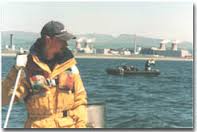Sellafield discharges two million gallons of radioactive water into the Irish Sea every day at high tide. This includes a cocktail of over 30 alpha, beta and gamma radionuclides. BNFL admits that radioactive discharges in the 1970’s were 100 times those of today. As a result of these discharges, which include around half a tonne of plutonium, the Irish Sea has become the most radioactively contaminated sea in the world. Caesium-137 and Iodine-129 from Sellafield have spread through the Arctic Ocean into the waters of northern Canada and are having a bigger impact on the Arctic than the Chernobyl accident. Sellafield’s gas discharges of Krypton can be measured in Miami.
The guinea pigs in a ‘deliberate scientific experiment’ to find out levels of contamination in the food chain, were the Cumbrian people and their environment. Claiming then that the radioactive materials discharged from the 2km pipeline would dilute and disperse into the wider oceans, the industry clearly got it wrong, with high levels of radioactive discharge material washed ashore and trapped in the coastal sands and sediments.
A leading government-backed scientist from East Anglia University discovered that plutonium particles, concentrated in waves breaking on the shore, was being blown over West Cumbria, as far as 37 miles inland.This was confirmed by analysis of vacuum cleaner house dust samples taken up and down the coast by a National Radiological Protection Board investigation.
That Sellafield plutonium gets everywhere was shown in post-mortem examinations of former Sellafield workers. Concentrations of hundreds and in one case thousands of times higher than in the general population were found. Cumbrians who never worked at the plant had plutonium levels ranging from 50% to 250% above the average compared to elsewhere in Britain. Atomic Energy Authority scientist, Prof. Nick Priest, studied the teeth of over 3000 young people throughout Britain and Ireland. He found traces of Sellafield plutonium in varying doses, the highest doses being closest to Sellafield.

In November 1983 a team of Greenpeace divers tried to block the Sellafield underwater discharge pipe. When they emerged from the water, their Geiger counters revealed that they were seriously contaminated. It was only when they publicised this fact that BNFL admitted to having problems with their radioactive discharges and that a tankfull of ‘radioactive crud’ had been flushed out to sea. As radioactive flotsam was being washed ashore, posing a danger to health, the Department of the Environment effectively closed the beach and warned the public not to use the fifteen-mile stretch of shoreline north and south of Sellafield. This advice stayed in force for a full six months. In June 1985 BNFL faced a three-day trial, was found guilty and fined £10,000.
BNFL’s own environmental monitoring figures for the first quarter of 1997 revealed alarmingly raised levels of Technetium 99 in seaweed samples from the West Cumbrian coast. A Tc-99 level of 180,000 Bq/Kg in seaweed was sampled from Drigg, just south of the plant. This compared to a level of 71,000 Bq/Kg sampled in the previous quarter and to a level of just 800 Bq/Kg in 1992. Via the food chain Tc-99 is now found in duck eggs, and the use of locally harvested seaweed as a garden fertiliser has led to the discovery of Tc-99 in locally grown spinach. Irish Sea lobster have shown a similar alarming rise from 210 Bq/Kg in 1993 to 52,000 Bq/Kg in 1997 – over 40 times the EU Food Intervention Level set as a safety level for foodstuffs contaminated following a nuclear accident. Raised levels of Tc-99 were subsequently found in Norwegian lobsters.
A wide range of fish, shellfish and molluscs continue to show varying degrees of radioactive contamination from Sellafield’s discharges.